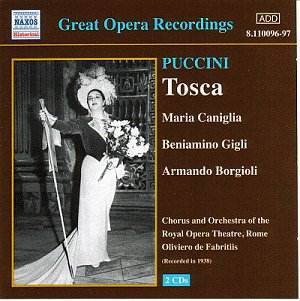Although a photograph of Maria Caniglia (presumably
as Tosca) adorns the cover of this Naxos re-issue, there is no doubt
as to who dominates the performance itself. Gigli was at the height
of his powers at this time, the leading dramatic-lyric tenor of the
day, and the natural heir to Caruso. By the time this celebrated recording
was made in 1938, Gigli had been singing Cavaradossi for nearly twenty
years, and it shows. Apart from the truly glorious quality of the voice
itself, he invests the character with warmth, humanity, and even humour
(where appropriate), a difficult balancing act that can only come from
real familiarity with the role.
Even though one approaches historic recordings with
some caution (certainly regarding sound quality), I was initially disappointed
with what I heard here. Puccini’s dramatic opening, with its rasping
trombones outlining the theme later to become the ‘Scarpia’ motif, should
leap out of the speakers and grab you by the throat. Here, a rather
distant, sourly tuned pit orchestra struggle to make any sort of impact.
Things improve markedly when the Sacristan makes his first entry, and
even more so when the power of Gigli’s voice is first encountered. So
it becomes more of an issue of balance, with the singers given a forward
prominence over the orchestra, and you soon adjust. Many later opera
producers still like to balance this way, and, for a 1938 vintage, the
voices are captured with excellent clarity and realism.
So forget about encountering too much of Puccini’s
wonderful woodwind detail, or hearing the inner horn and string voicings
(as you do in Karajan’s classic Decca version). Revel instead in listening
to a truly Italian verismo tradition, where the high tessitura
holds no fears, and the singers perform as to the manor born. Caniglia
was a famous Tosca in her day, and gives a characterful rendition of
the eponymous heroine. She may lack the dark toned, sexy allure of Leontyne
Price (for Karajan) or the sheer spine-tingling drama of Callas (for
Victor de Sabata on EMI), but this is a convincing portrayal, if a little
shrill in places. She does not spit venom, as Callas does, at Scarpia’s
advances, but her sincerity is moving in its own way. ‘Vissi d’arte’
is sung with total honesty, but at a rather forceful level throughout;
Price is exemplary here.
Borgioli sang in all the world’s great opera houses
(including the Met.), and knew Gigli well, so there is plenty of interaction
when required. He is slightly wooden in places (as when he prepares
to interrogate Cavaradossi), but the voice has a firmness and richness
that are very satisfying – try his famous first entry in the church.
As mentioned before, the set really belongs to Gigli,
whose voice is magnificent. ‘Recondita armonia’ soars in a thrilling
way that is rare on disc, and we can forgive him his famous over-acting
in places (such as the melodramatic torture scene). Hearing this voice
makes one agree with the gloom merchants, who say that the great days
of Italian tenors are over.
The conducting is workman-like rather than inspired,
and once one is used to the balance, the sound is enjoyable enough.
The highlights of the French Tosca are interesting for Ninon
Vallin’s portrayal, but with a poor Cavaradossi (Enrico di Mazzei) and
terrible sound (even Ward Marston has to admit to not being able to
rescue this), it’s one for the specialist only.
As for the Gigli Tosca, another invaluable reincarnation
from Naxos Historical.
Tony Haywood


